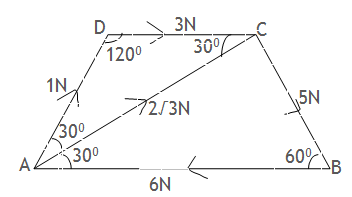1. The table below shows the commuter h=bus fares from stage A to stages B, C, D and E
|
Stage |
A |
B |
C |
D |
E |
|
Distance (km) |
0 |
12 |
16 |
19 |
23 |
|
Fare (Shs) |
0 |
1300 |
1700 |
2200 |
2500 |
a) Jane boarded fro mA and stopped at a place 2km after E. How much did she pay?
b) Okello paid Shs 2000. How far from A did the bus leave him?
2. A stone is thrown vertically upwards with velocity 16ms-1 from a point H metres above the ground level. The stone hits the ground 4 seconds later.
Calculate the;
a) value of H
b) velocity of the stone as it hits the ground
3. A discrete random variable X has the following probability distribution:
|
x |
0 |
1 |
2 |
3 |
4 |
5 |
|
P(X = x) |
0.11 |
0.17 |
0.2 |
0.13 |
p |
0.09 |
Find the;
a) value of p
b) expected value of X
4. Use the trapezium rule with seven ordinates to estimate

correct to 2 decimal places
5. A uniform rod AB of length 3m and mass 8 kg is freely hinged to a vertical wall at A. A string BC of length 4m attached to B and to a point C on the wall, keeps the rod in equilibrium. If C is 5m vertically above A, find the;
a) tension in the string
b) magnitude of the normal reaction at A
6. The table below shows the masses of bolts bought by a carpenter
|
Mass (grams) |
98 |
99 |
100 |
101 |
102 |
103 |
104 |
|
Number of bolts |
8 |
11 |
14 |
20 |
17 |
6 |
4 |
Calculate the;
a) median mass
b) mean mass of the bolts
7. The amount of mrat sold by a butcher is normally distributed with mean 43kg and standard deviation 4kg. Determine the probability that the amount of meat sold is between 40kg and 50kg.
8. A particle is movung with Simple Harmonic Motion (SHM). When the particle is 15m from the equilibrium, its speed is 6ms-1. When the particle is 13m from the equilibrium, its speed is 9ms-1. Find the amplitufr of the motion.
9. Car A is 80m North West of point O. Car B is 50m N300E of O. Car A is moving at 20ms-1 on a straight road towards O. Car B is also moving at 10ms-1 on another straight road towards O. Determine the;
a) initial distance between the two cars
b) velocity of A relative to B
c) shortest distance between the two cars as they approach O
10. The table below shows the marks obtained in a Mathematics test by a group of students.
|
Marks |
5 - < 15 |
15-<25 |
25-<35 |
35-<45 |
45-<55 |
55-<65 |
65-<75 |
75-<85 |
|
Number of Students |
5 |
7 |
19 |
17 |
7 |
4 |
2 |
3 |
a) Construct a cumulative frequency curve (Ogive) for the data
b) Use your Ogive to find the;
i) range between the 10th and 70th percentiles
ii) probability that a student selected a random scored below 50 marks
11.a) Show that the equation x -3sin x =0 has a root between 2 and 3
b) Show that the Newton – Raphson iterative formula for estimating the root of the equation in (a) is given by

Hence find the root of the equation correct to 2 decimal places
12. A force F= (2t I + j – 3t k) N acts on a particle of mass 2kg. The particle is initially at a point (0,0,0) and moving with a velocity
(i +2j - k)ms-1
Determine the;
a) magnitude of the acceleration of the particle after 2 seconds
b) velocity of the particle after 2 seconds
c) displacement of the particle after 2 seconds
13. Two events A and B are such that

Determine the;

14. Given that y = ex and x = 0.62 correct to two decimal places, find the interval within which the exact valuw of y lies
b) Show that the maximum possible relative error in

Hence find the percentage error in calculating

15. The diagram below shows a trapezium ABCD. AD = DC = CB = 1 metre and AB = 2 meters.
Forces of magnitude 1N, 3N, 5N, 6N and 2√3N act in the directions AD, DC, CB, BA and AC respectively

a) Calculate the magnitude of the resultant force and the angle it makes with side AB
b) Given that the line of action of the resultant for meets AB at X, find the distance AX
16. A biased die with faces labeled 1,2,2,3,5 and 6 is tossed 45 times. Calculate the probability that 2 will appear;
a) more than 18 times
b) exactly 11 times
END
